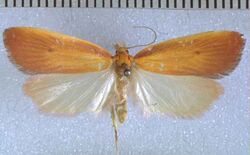Biology:Proteodes smithi
| Proteodes smithi | |
|---|---|

| |
| Male holotype | |
| Scientific classification | |
| Domain: | Eukaryota |
| Kingdom: | Animalia |
| Phylum: | Arthropoda |
| Class: | Insecta |
| Order: | Lepidoptera |
| Family: | Depressariidae |
| Genus: | [[Biology:|Proteodes]] |
| Species: | P. smithi
|
| Binomial name | |
| Proteodes smithi Howes, 1946[1]
| |
Proteodes smithi is a species of moth in the family Depressariidae.[2] It is endemic to New Zealand and is known from Homer in Fiordland, as well as other localities in the south western parts of the South Island. It has been observed tussock and mixed shrub habitat above the tree line at approximately 1000 m altitude. Adults are on the wing from December until April and are attracted to light.
Taxonomy
This species was described by George Howes in 1946 using a specimen collected in early January at Homer, Fiordland by T. R. Smith, in whose honour this species is named.[3][4] The male holotype specimen is held at Te Papa.[4]
Description
Howes described the species as follows:
Wing expanse 31 mm. Head and face uniform golden brown, antennae brown. Palpi prominent, upcurved, basal portions pink, the tips yellow. Thorax and crests warm brown. First two pairs of legs pink, hindlegs ochreous. Forewings: costa bowed; apex not obtuse—termen rather rounded. An orange band runs along costa narrowing at base and apex. From the base an orange coloured area extends through centre of wing as far as the discal dot. The rest of the forewing is a warm orange brown deepening to warm brown at the termen. Along the veins thin orange coloured streaks extend out towards the termen. Cilia brown, duller than the main wing colouring. Lower wings silvery white with a pink suffusion along the terminal edge. Cilia pink.[3]
This species is similar in appearance to Proteodes clarkei but differs in that the wings are broader, the colouration is brighter and in the male the antennal pectinations are significantly shorter than those of P. clarkei.[3]
Distribution
This species is endemic to New Zealand and known from its type locality of Homer.[1][3] It has also been observed in the south west of the South Island near Milford Sound and north of Lake Astelia in Southland.
Habitat
The adults of this species have been observed in terrain that contained tussock, mixed scrub and rocks, above the tree line at about 1000 m.
Behaviour
Adults have been observed as being on the wing from December until April. This species is attracted to light.[5]
References
| Wikimedia Commons has media related to Proteodes smithi. |
- ↑ 1.0 1.1 "Proteodes smithi Howes, 1946". https://www.nzor.org.nz/names/0a6d9648-9a49-412b-865a-5f44c8cd6f58.
- ↑ , pp. 458, Wikidata Q45922947
- ↑ 3.0 3.1 3.2 3.3 , pp. 146, Wikidata Q62091906
- ↑ 4.0 4.1 , pp. 88, Wikidata Q45083134
- ↑ Possums' End (2021-12-17). "Proteodes smithi" (in en). https://www.inaturalist.org/observations/103208839.
Wikidata ☰ Q14175523 entry
 |


